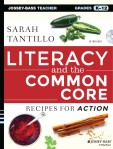 Here are some things to work on before you begin preparing students for the genre of standardized testing this year:
Here are some things to work on before you begin preparing students for the genre of standardized testing this year:
Review/teach The Comprehension Process using the TLC Comprehension Process Staircase here.
- You will need an anchor chart of this process for reference.
- To reinforce the idea that we use the Comprehension Process all the time, apply it to an image using the “Quadrant Analysis” approach described here. PS, this is also a great way to stimulate student interest and build background knowledge about a topic they will soon read about.
Review/teach the skill of paraphrasing (the first step in comprehension). For more information, see TLC Blog here. Use the “How to Paraphrase” organizer that applies to your grade (see TLC Website here).
Review/teach 5Ws and H (questioning and answering).
- Read a text with students, and model how to ask and answer these questions about the text. Note: Make sure students do not conflate “how” and “why,” which is a common mistake–i.e., we cannot allow them to answer “How” questions with “because.” Example:
- How did the character’s appearance change?
- Why did the character’s appearance change?
- Give students another text, and they apply this skill with a partner. Then they do it alone for homework.
- Students should practice using these questions FREQUENTLY. They feed nicely into summarizing because if you can ask and answer 5Ws and H questions about a text, you should be able to pull out key information to support your summary.
- For more information, see TLC Blog on the most important Common Core Reading Standard, which focuses on the 5Ws and H questions (using the “5Ws and H organizer”).
Review/teach Argument vs. Evidence Steps 1, 2, 3, and 4. Note: Steps 1 and 2 (and 2.5) can be done in a few lessons. You can spend the rest of your life on Steps 3 and 4.
- Given a list of statements, distinguish the arguments from examples of evidence. See TLC Blogs here and here.
- Given a list of statements, identify arguments and their relevant evidence. See TLC Blog here. For “Step 2.5,” see TLC Blog here, here, and here.
- Given arguments, support them with your own relevant evidence and explanation. See TLC Blog here and here.
- Given questions, answer them with arguments and relevant evidence and explanation. See TLC Blog here.
Practice close reading of a text by questioning the text.
- Use the QIEE (Question-Inference-Evidence & Explanation) approach (using the QIEE organizer) described here.
- Or, put question marks in the margin and dive into paired discussions or whole-class discussion as appropriate.
- Move toward summary statements beginning with expressions such as “In this text, the author is trying to convey that…” or “The author’s main argument is that….”
- A Cornell Notes organizer can help scaffold this process, too.
- Remind students that a topic sentence is an argument, NOT a fact. This argument can then be supported with evidence and explanation.
Review/teach students how to figure out “what’s important” in a narrative (whether fictional or not) using the “What’s Important Organizer.” Check out this TLC Blog here.
Model and practice summarizing skills:
- Given a quote from a famous person, students restate it in fewer words.
- Given a paragraph of content, students restate it in one sentence.
- Given an essay, students apply 5Ws and H questions and then summarize it in a paragraph.
Teach how and why to skim. See TLC Blog post on the overlooked skill of skimming.
Move into PARCC prep mode. Unpacking and paraphrasing the question is a critical first step. For example, before diving into the TLC Blog on how to tackle the Research Writing Task, show students a Research Simulation Task prompt (see “PARCC Research Simulation Writing Prompts” on TLC “PARCC Prep” page). Note that the prompt is NOT WORDED AS A QUESTION, and our first step is to TURN IT INTO A QUESTION. We do this by circling the question word (usually WHY or HOW) and starting our question with that question word. Note: If the prompt does not include “how” or “why,” look for “compare/contrast.” Prompts that use “compare/contrast” should be turned into “how” questions (as illustrated below). For more information on this process, click here.
Examples: [Note: I have underlined the question word(s).]
Original Grade 5 prompt:
Compare how the articles by Lauren Tarshis and Dyan deNapoli and the video describe penguin rescue efforts after oil spills. Support your essay with information from all three sources.
Unpacked Grade 5 prompt:
How do the articles by Lauren Tarshis and Dyan deNapoli and the video describe penguin rescue efforts after oil spills?
***
Original Grade 6 prompt:
You have read two texts and viewed one video that claim that the role of zoos is to protect animals. Write an essay that compares and contrasts the evidence each source uses to support this claim. Be sure to use evidence from all three sources to support your response.
Unpacked Grade 6 prompt:
How does each source use evidence to support the claim that the role of zoos is to protect animals?
From here, you can move into more explicit PARCC preparation.
- For general thoughts on how to pace PARCC writing prep, click here.
- For how to approach the Research Simulation Task, click here.
- For how to approach the Literary Analysis Task, click here, here, here, and here.
- For how to approach the Narrative Writing Task, click here and here.
PS: Many thanks to Dominy Alderman at HoLa Charter School for encouraging me to put this material together!


Pingback: PARCC Prep: Literary Analysis Writing Lesson Cycle | The Literacy Cookbook blog
Pingback: CCSS Test Prep: Literary Analysis Writing
Pingback: PARCC Prep: Literary Analysis Writing Lesson Cycle UPDATED, 1-28-2020 | The Literacy Cookbook blog